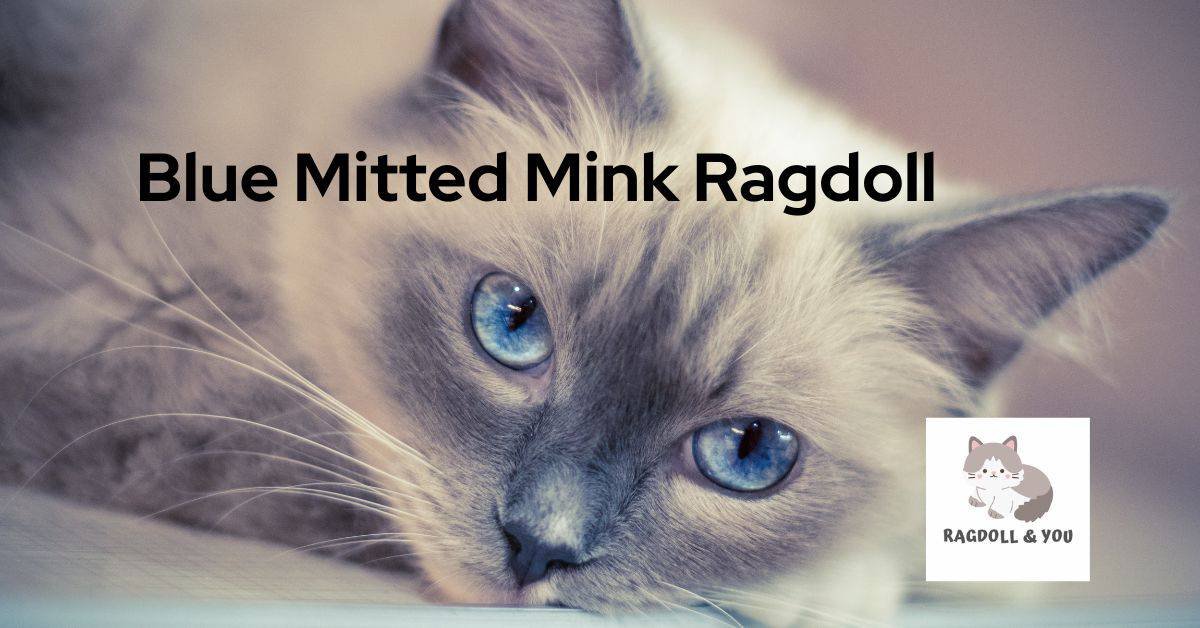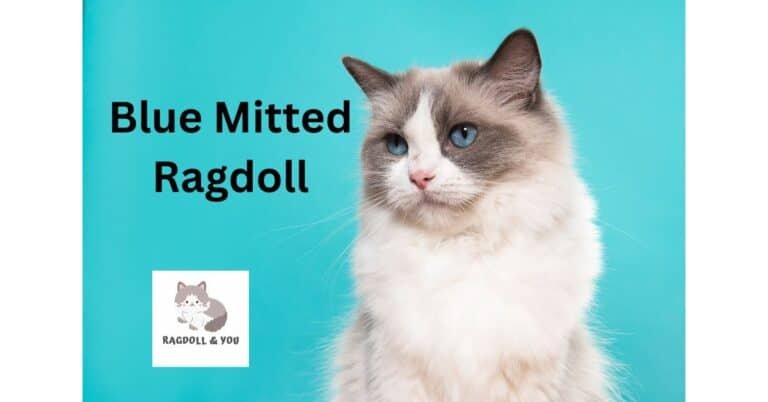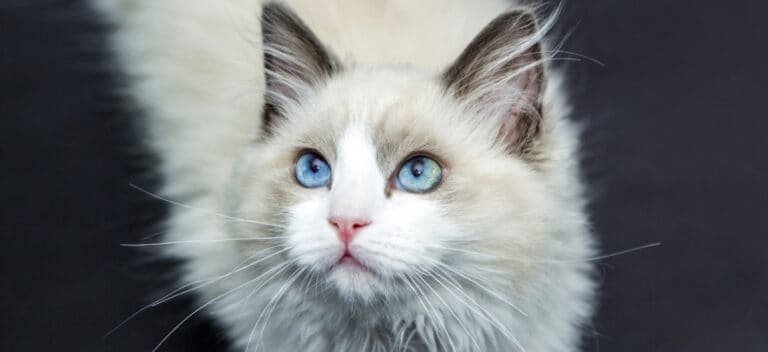Blue Mitted Mink Ragdoll: Complete Guide With Breed Profile
The Blue Mitted Mink Ragdoll is a rare cat breed admired for its soft blue-gray fur and bright aqua eyes. This gentle, kid-friendly breed has a laidback “ragdoll” personality.
True to their name, Blue Mitted Mink Ragdolls have mitted paws and pointed facial markings in a luxurious mink-like grayish blue shade. They go limp when picked up.
Despite their long silky coats, Blue Mitted Mink Ragdolls are relatively low maintenance. They are playful, love to cuddle, and do well with children and pets when socialized properly.
This article provides an overview of this beautiful breed – from history and physical features to personality and care needs. It covers the key information potential owners would want to know about the endearing Blue Mitted Mink Ragdoll.
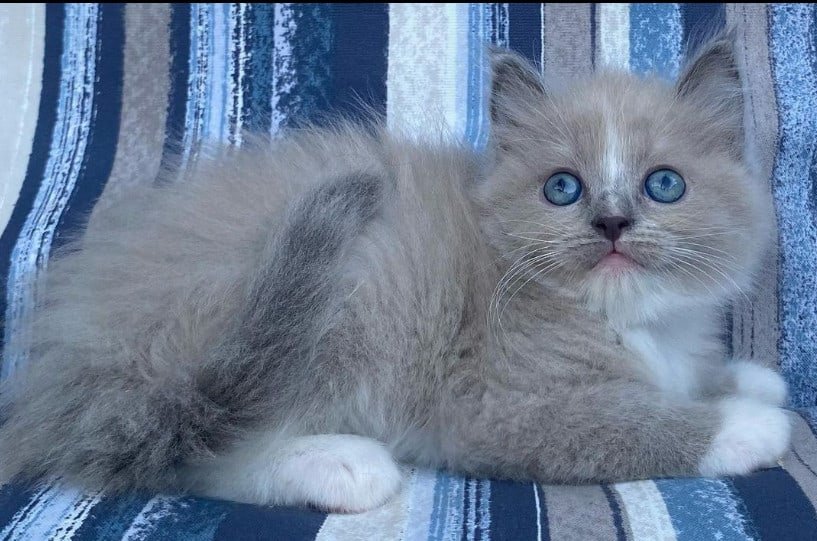
Key Features
- Pointed markings (darker ears, face, feet, and tail)
- Soft, blue-gray fur
- Gentle and affectionate personality
- Loves to cuddle
- Ragdoll” personality (goes limp when picked up)
- Low-maintenance
- Suitable for families with children
In-Depth Look at Blue Mitted Ragdoll Breed Profile
The blue-mitted ragdoll breed is known for its physical appearance, personality traits, training and exercise requirements, grooming needs, health issues, and lifespan.
Physical Appearance And Colors
The Blue Mitted Ragdoll cat has a light body with slate gray spots. These gray spots show on the face, ears, paws, and tail.
People often say this looks like a mask or gloves. The coat is soft and silky and not too long.
Their eyes are blue, which is common in the Ragdoll breed. Some cats have more white marks than others. These special marks can look like two colors or mitten shapes on their coats.
Personality Traits
Blue mitted Ragdoll cats are very loving. They love to play with both kids and grown-ups. These cats like to be around people. They want lots of hugs and pets.
They are also calm yet fun to be around. Their easygoing nature makes them great pets for any home. A blue mitted Ragdoll cat is sweet, relaxed, and gentle.
Training And Exercise Requirements
Blue mitted Ragdoll cats need the right kind of exercise. Here is what you need to know:
- These cats do not need a lot of hard play. Still, regular exercise and playtime are essential.
- You should provide some mental workout for your cat. Fun toys can be a good choice.
- Ragdolls like snuggle time and love from their owners.
- Be sure to change up the games and toys often for interest.
- Some outdoor play is okay with close watch.
- Always keep safety in mind, especially if you have an indoor-only cat.
Grooming And Cleaning Needs
Ragdoll cats have simple grooming needs. Here are some essential things to know:
- Their coats are medium-length and have a silky texture.
- Regular grooming is needed to keep their coats in good condition.
- They are generally very clean animals and care for most of their grooming.
- However, they may still need some assistance from their owners with brushing and combing.
- Ragdolls should be brushed at least once a week to remove loose hairs and prevent matting.
- Use a comb or brush specifically designed for cats with medium-length fur.
- Pay extra attention to areas where mats are more likely to form, such as behind the ears and under the armpits.
- Bathing is usually not necessary unless the cat gets dirty or has a medical condition that requires it.
- Use a mild cat shampoo if bathing is necessary, and make sure to rinse off all the soap thoroughly.
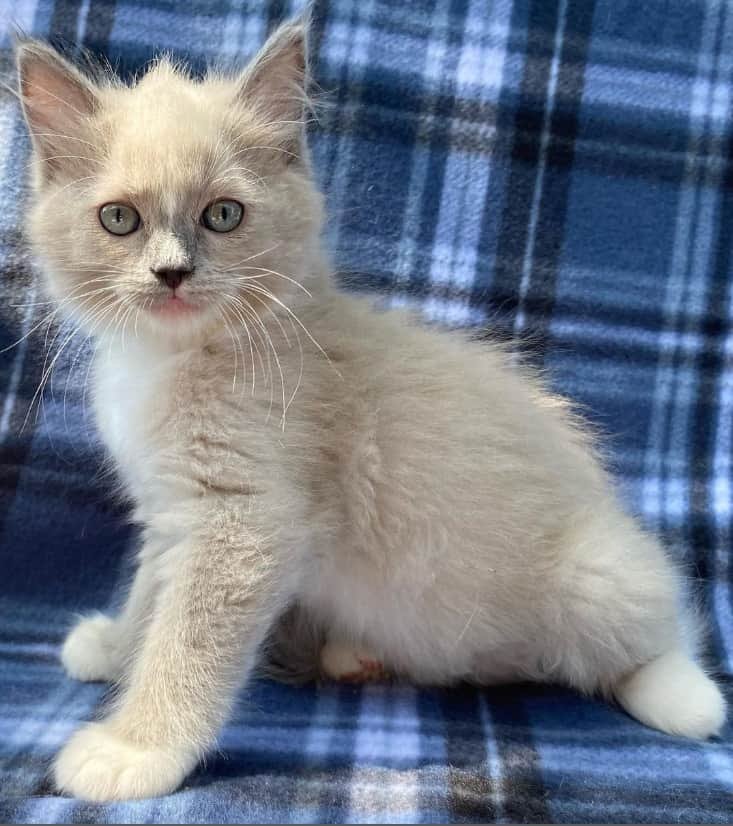
Health Issues And Lifespan
Blue Mitted Ragdoll cats have an average lifespan of 12 to 16 years. They are generally healthy and can live a happy, long life. However, like all breeds, they may be prone to specific health issues.
One common health concern for Ragdolls is hypertrophic heart disease. Monitoring their heart health and visiting the vet regularly for check-ups is essential.
Despite these potential health issues, Blue Mitted Ragdolls are known for their overall good health and can bring joy to your family for many years.
Finding A Reputable Breeder And Price Considerations
When looking to adopt a Blue Mitted Ragdoll kitten, it is essential to find a reputable breeder. Reputable breeders carefully select their breeding pairs and prioritize the health and well-being of the cats.
They follow responsible breeding practices to ensure that kittens are healthy and have good temperaments.
Do thorough research, ask for recommendations from trusted sources, and visit the breeder in person.
When considering price, it’s worth noting that Ragdoll cats can vary greatly in cost.
While you may find lower-priced options at animal shelters or through adoption fees, show-quality animals from registered breeders can be priced higher due to their desirable traits and careful breeding efforts.
Blue Mitted Ragdoll vs. Blue Lynx Mitted Ragdoll
Blue Mitted Ragdolls and Blue Lynx Mitted Ragdolls share many similarities due to their genetic lineage, but they also have distinct traits that set them apart. Both breeds share the characteristic blue eyes and a luxurious coat.
| Blue Mitted Ragdoll | Blue Lynx Mitted Ragdoll |
| The Blue Mitted Ragdoll has a darker gray body coat than other ragdoll cat breeds. | The Blue Lynx Mitted Ragdoll, like the Blue Mitted Ragdoll, has blue-tipped fur. The Lynx point markings, which feature tabby stripes on their fur, set this breed apart. |
| The Blue Mitted Ragdoll has white mittens, adding another layer of distinctiveness to their look. | Blue Lynx lynx-mitted ragdolls also have white mittens, but their lynx point markings differentiate them. |
Understanding Blue Mitted Ragdoll Genetics
Discover the fascinating world of Ragdoll genetics and unravel the mysteries behind their unique blue mitted patterns.
Dilution Genes
Dilution genes play a significant role in the coloration of blue mitted Ragdolls. These genes reduce and spread pigment granules along the hair shaft, resulting in different fur colors.
For example, they can change the fur color from seal to blue or chocolate to lilac. In black fur, dilution genes can create a gray-blue shade known as “blue” among Ragdoll breeders.
Understanding these genes is crucial for predicting the colors and patterns of future litters and maintaining breed standards in Ragdolls.
Colorpoint Genes
Colorpoint genes play a crucial role in determining the color pattern of Ragdoll cats. These genes are responsible for the beautiful color points on their ears, faces, paws, and tails.
In the case of Ragdolls, the colorpoint pattern is determined by a recessive gene known as the CS gene. A cat must possess two copies of this gene to have visible color points.
Blue mitted Ragdolls typically display this pattern but can also be found in other recognized colors within the breed.
Understanding these genetics helps breeders produce kittens with desired coat patterns and assists potential owners in identifying their preferred Ragdoll variety based on its unique coloring traits.
White spotting genes
The white spotting gene plays a crucial role in the genetics of blue mitted Ragdoll cats, especially those with the mink pattern.
Breeders in the USA specifically look for cats with a high mitted bicolor pattern because it indicates the presence of the white spotting gene.
Depending on whether a cat has one or two copies of this gene, they will have varying amounts of white markings on their coat.
The Ragdoll breed has a unique genetic characteristic where both the mitted and bicolor patterns have a dominant white spotting gene.
It’s important to note that this single gene does not solely determine white spotting in cat coats; it is a complex trait influenced by other genes, some of which are still unknown.
Comprehensive Guide to Blue Mitted Ragdoll Care and Feeding
Proper diet and nutrition
Proper diet and nutrition are crucial for keeping your blue-mitted ragdoll healthy and happy. Here are some essential tips to ensure they get the right kind of food:
Measure Their Food:
Ragdolls tend to overeat, so measuring their meals and preventing weight gain is essential.
Choose A Complete Formula:
Look for a nutritional formula designed explicitly for Ragdolls. This will give them the right balance of nutrients to support their energy needs for vital functions.
Balanced Diet:
Ensure your ragdoll’s diet includes a variety of high-quality proteins, fats, carbohydrates, vitamins, and minerals. A balanced diet is essential for their overall health.
Life Stage-Specific Diet:
As your ragdoll grows older, their nutritional requirements may change. Adjust their diet as needed to meet the specific needs of each life stage.
Portion Control:
Feeding your ragdoll the appropriate portion size based on their age, weight, and activity level is essential. This helps maintain a healthy weight and prevents overeating.
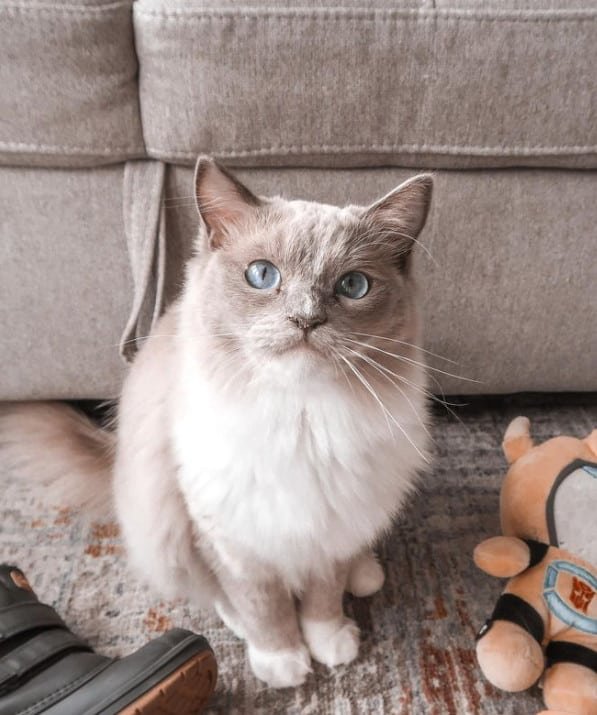
Health Issues
Hypertrophic Cardiomyopathy (HCM):
This heart disease is more prevalent in Ragdolls compared to other cat breeds. Regular veterinary check-ups can help detect and manage this condition.
Polycystic Kidney Disease (PKD):
Ragdolls can be prone to hereditary kidney disease. Regular screenings can help identify any early signs of PKD.
Obesity:
Due to their hearty appetite, ragdolls are at risk of becoming overweight or obese. Maintaining a healthy diet and providing regular exercise can help prevent weight gain.
Grooming tips for maintaining coat health
To keep a Blue Mitted Ragdoll’s coat healthy, here are some grooming tips:
- Regular brushing: Brush your Ragdoll’s coat at least twice weekly to prevent tangles and keep it soft and silky.
- Bathing: While ragdolls generally don’t require frequent baths, occasional bathing can help keep their coat clean and free from dirt or oil buildup.
- Pay attention to the ears: Check and clean the areas behind your cat’s ears regularly, as this is a familiar spot for accumulating dirt and debris.
- Prevent matting: Comb your Ragdoll’s fur, especially if they have a heavier undercoat, to prevent matting.
- Start grooming early: Get your Ragdoll used to grooming from a young age so that they become comfortable with the process.
- Use appropriate tools: Use a brush or comb for cats with medium-length coats to ensure effective grooming.
- Be gentle: When brushing or combing your cat’s fur, be gentle to avoid causing any discomfort or pain.
- Watch for signs of skin issues: Look for any redness, rashes, or bald patches on your Ragdoll’s skin, and consult a veterinarian if you notice anything concerning.
Common health issues to be aware of
Ragdolls, including the Blue Mitted variety, can have some health concerns that owners should be aware of. One important issue is weight gain and obesity.
Ragdolls are prone to gaining excess weight, so it’s crucial to monitor their diet and provide regular exercise to keep them at a healthy weight.
Another concern is hip dysplasia, a hereditary condition that can cause painful arthritis in the hips.
Common health problems in Ragdolls include mouth and gum disease, respiratory tract disorders, heart disease, kidney disease, and gastrointestinal disorders.
Despite these potential issues, Ragdolls are generally considered a breed with lower health risks than others.
Is a Blue Mitted Ragdoll the Right Breed for You?
If you’re looking for a cat with a unique appearance, then a Blue Mitted Ragdoll might be the right breed for you.
With their darker gray body coat color and beautiful blue eyes, these cats have a distinct look that sets them apart from other breeds.
They are known for their large size, making them quite impressive in your home.
Blue Mitted Ragdolls share many characteristics with other Ragdoll cats. They have a calm and friendly personality, which makes them great companions for families or individuals.
These cats are generally easygoing and enjoy being around people.
When considering if a Blue Mitted Ragdoll is the right breed for you, it’s also essential to understand their grooming needs.
While they have semi-long fur that doesn’t mat easily, regular brushing is recommended to keep their coat healthy and shiny.
Conclusion
In conclusion, the Blue Mitted Mink Ragdoll is a unique and beautiful breed with its blue-gray pigmentation and aqua eyes.
Their gentle disposition and child-friendly nature make them great companions for families.
Whether it’s their large size or silky fur, these cats will surely steal your heart.
Take the time to understand their care needs and find a reputable breeder if you’re considering adding one of these magnificent cats to your family.
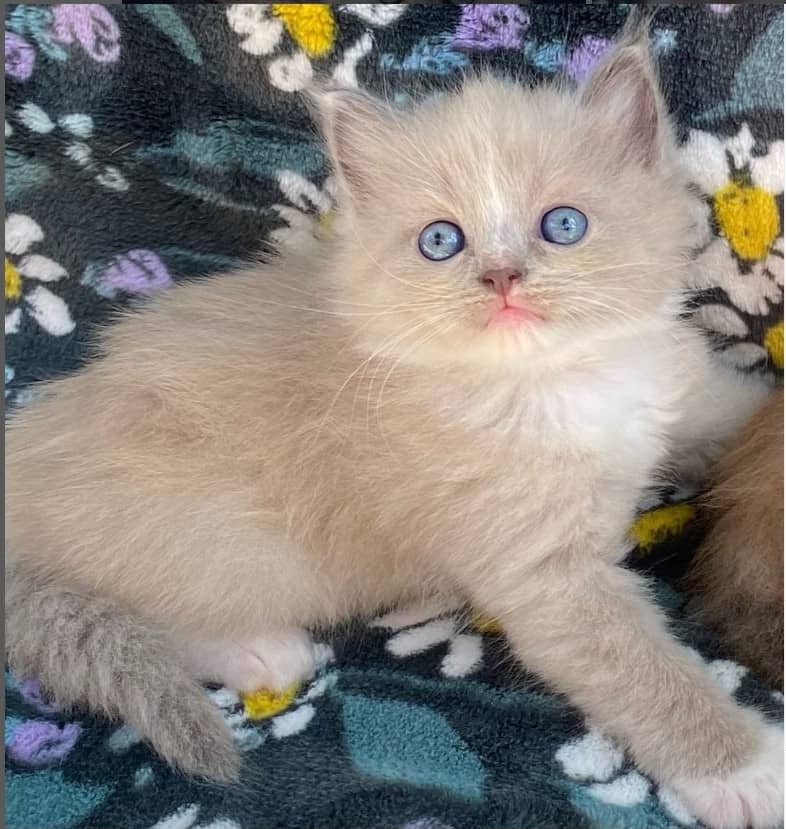
FAQs
1. What Is A Blue Mitted Mink Ragdoll?
A blue-mitted mink ragdoll is a specific color and pattern variation of the ragdoll cat breed, characterized by its blue-tinged fur, white mittens on the paws, and semi-long coat.
2. How Big Do Blue Mitted Mink Ragdolls Get?
Blue-mitted mink ragdolls are medium to large-sized cats, with males typically weighing 12-20 pounds (5.4-9 kg) and females weighing 8-15 pounds (3.6-6.8 kg).
3. Are Blue Mitted Mink Ragdolls Good Pets For Families?
Blue-mitted mink ragdolls are known to be gentle, affectionate, and good with children and other pets, making them great family companions.
4. Do Blue Mitted Mini Ragdolls Require Special Grooming?
While they have semi-long fur that requires regular brushing to prevent matting and keep it looking its best, their plush coats don’t usually tangle as quickly as some other long-haired breeds.
5. Can You Show Blue Minited Mini Ragdolls In Cat Shows?
Yes! Blue minited mini ragdolls can compete in cat shows if they meet the breed standards set by cat associations such as The International Cat Association (TICA) or The Cat Fanciers’ Association (CFA).

